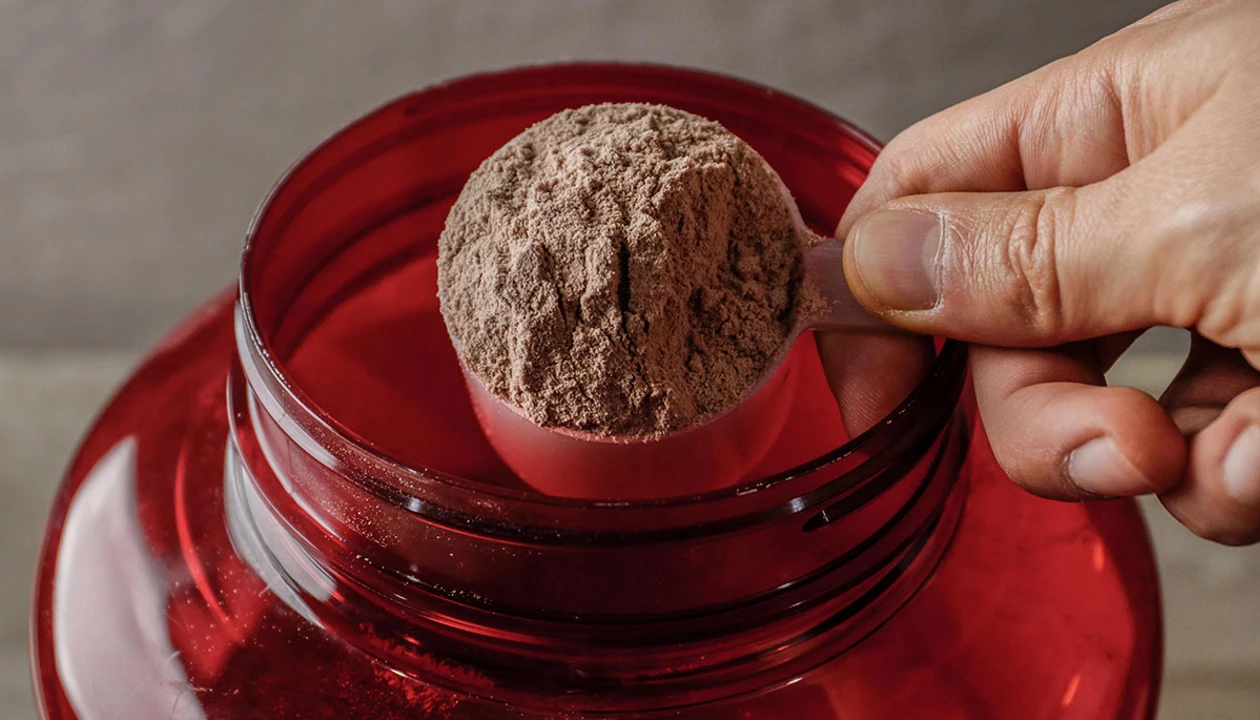Key Insights
Consumer Reports recently tested popular protein powders for lead and found levels considered concerning in several of the products.
There is no known safe level of exposure to lead, but some exposure to trace amounts is inevitable. Plants like the peas and rice used in protein powder take up lead naturally from the environment.
Protein powder makers say their products and manufacturing processes follow US Food and Drug Administration guidelines. Consumer Reports prefers stricter California standards.
A recent investigation by Consumer Reports into lead in protein powders and shakes has drawn significant public attention. The consumer advocacy group bought samples of 23 popular products from stores and online retailers and found that two-thirds of these products contained more than 0.5 μg of lead per serving, the threshold that it considers concerning.
“There’s no way to completely avoid trace amounts of lead in products,” says Pieter Cohen, a doctor of internal medicine at Cambridge Health Alliance who leads the group’s supplement research program. He wasn’t involved in the Consumer Reports investigation. But he recommends caution. “If there is protein powder with almost no lead in it, zero or almost none, that’s what you should be consuming.”
“There’s no immediate harm from the amount of lead that we found in these products.”
Sana Mujahid, manager of food safety research and training, Consumer Reports
How bad is it to eat or drink lead?
Health experts generally agree that there is no known safe level of exposure to lead. It can affect every organ system and can especially harm children by preventing them from absorbing minerals that their brains and nervous systems need to develop properly. Adults chronically exposed to lead can also suffer neurological damage, as well as kidney dysfunction and high blood pressure.
But because lead occurs naturally in the environment, avoiding it altogether is impossible. In the US, people are most likely to be exposed through food and drinking water.
The Food and Drug Administration sets guidelines for levels of lead exposure from food that particularly at-risk populations should avoid. The current interim reference levels are 2.2 μg per day for children and 8.8 μg per day for women of child-bearing age. The threshold Consumer Reports chose was much lower—0.5 μg per day. That is the maximum allowable dose of lead per day set by the California Office of Environmental Health Hazard Assessment under the state’s Proposition 65 law, which warns consumers of products that may cause cancer.
“We go by the California standard because it is the most strict,” says Brian Ronholm, Consumer Reports’ director of food policy. Some of the protein powders the group tested did achieve the stricter California standard. “There are products that can reach this level, and so it is possible,” Ronholm says.
In a statement, Huel, one of the manufacturers in Consumer Reports’ study, criticizes the decision to follow California, saying that regulators there included an unnecessarily large safety buffer in the lead limit. “It’s not a food safety limit. It’s a warning law designed to flag even theoretical exposures, including those that occur naturally in foods like spinach, rice, and nuts,” the company says.
How does lead get into protein powder?
Lead is present naturally in soil around the world. The metal has also entered the environment from pollution: exhaust from cars using leaded gasoline was a major source of lead pollution and exposure throughout much of the 20th century.
Protein powder is generally made from plants or dairy products, and occasionally from meat. Consumer Reports found that the plant protein powders it tested had higher amounts of lead than the dairy and meat protein powders.
Plants absorb lead and other heavy metals from the soil as they grow. Some plants accumulate more lead than others, and some regions have more lead in the environment for plants to take up. Root vegetables tend to have higher concentrations of lead than other vegetables and fruits that people eat.
The two products found to have the highest lead levels, Naked Nutrition’s Vegan Mass Gainer and Huel’s Black Edition, get their protein from peas and rice, according to the companies’ websites.
Naked Nutrition says in a statement that Vegan Mass Gainer has a larger serving size and that per gram it has lead amounts similar to those in other plant-based protein products. The company added: “While Consumer Reports did not share its complete lab data, we reviewed the available information and verified results through independent third-party testing, which confirmed that no heavy metals exceeded FDA reference intake levels for adults, including for sensitive groups such as women of childbearing age.”
Huel sources its pea protein from the US and its rice protein from China. A company representative tells C&EN in an emailed statement, “We also work closely with growers and suppliers to source peas from regions where soil quality is carefully managed, which helps minimise the presence of naturally occurring elements like lead.”
It’s also possible for products to become contaminated with lead during the manufacturing process.
“Supplement manufacturers are required to follow the FDA’s Good Manufacturing Practices (GMPs), but we cannot speak in generality about these issues, because the approach companies take differs, in part because their product lines are also very different,” a spokesperson for the Council for Responsible Nutrition, a trade association that represents supplement makers, tells C&EN in an email.
How and why did Consumer Reports conduct this testing?
Consumer Reports first tested protein powders and shakes for lead 15 years ago, and its staff wanted to conduct another round of testing given the growing popularity of protein supplements, says Sana Mujahid, the organization’s manager of food safety research and training.
She and her colleagues chose the most popular products on the market and sent samples of them to an independent laboratory, which tested for lead and other heavy metals. The lab used triple quadrupole inductively coupled plasma cell mass spectrometry, in accordance with the Association of Official Analytical Chemists method 2015.01.
Consumer Reports has published a summary of its methodology online.
Mujahid doesn’t want consumers to panic. “There’s no immediate harm from the amount of lead that we found in these products,” she says. But chronic exposure from daily use could become a problem, she says, especially given that people are also being exposed to lead from other sources in their food and environments. “They should try to lower their exposure to lead wherever they can,” she says.
Does anyone regulate lead in protein powder?
The Consumer Reports analysis highlights how underregulated dietary supplements are in the US. The FDA regulates supplements separately from foods and drugs and does not review or test products before they enter the market. The agency also does not set specific limits on the amount of lead these products can contain, although companies are prohibited from selling “adulterated” products. In addition, firms must follow the FDA’s current good manufacturing practices, which require manufacturers to take precautions against introducing contaminants like lead and to test for contaminants.
Some companies opt for third-party testing and certification. Huel sends its protein powders to be tested by the National Sanitation Foundation (NSF), which found less than 3.6 μg in a daily serving of Black Edition’s chocolate flavor.
The company’s press department also tells C&EN via email: “Every supplier goes through Huel’s approval process, which includes a full review of their food safety systems, quality controls, and regulatory compliance. All suppliers hold GFSI [Global Food Safety Initiative]–recognised certification and are regularly audited by Huel.”
In its statement published online, Naked Nutrition says: “All Naked Nutrition ingredients are sourced from select suppliers that provide Certificates of Analysis, including heavy metals testing. We also retain samples from every production lot for ongoing verification, and Naked Vegan Mass Gainer is currently undergoing NSF Content Certification, which includes label-claim, toxicology, and contaminant testing.”
The FDA does set action levels for lead in some food products, including recently set action levels for baby food. These guidelines are not legally binding, but if a product exceeds the action level for its category, the FDA can consider it adulterated and potentially remove it from the market. There are currently no action levels for protein supplements.
“If there is protein powder with almost no lead in it, zero or almost none, that’s what you should be consuming.”
Pieter Cohen, Doctor of internal medicine, supplement research program lead, Cambridge Health Alliance
So should I stop using protein powder?
While it’s impossible to completely avoid lead, health experts recommend minimizing your exposure as much as you can.
“We’re not in the business of telling people what they should eat,” Ronholm says. “This is one of those situations where we want to provide consumers with the best information possible, so that they can make the right decisions. There are products that have lower numbers, so those are certainly viable options.”
Delger Erdenesanaa Delger is a DC-based reporter covering federal and state policy and regulation on chemicals in food, agriculture and water. She focuses on PFAS, pesticides and PBTs (persistent, bioaccumulative and toxic chemicals). Delger has written about science, environmental issues, climate change and the ocean for The New York Times, the Texas Observer and Inside Climate News. She has a master’s degree in science reporting from New York University
Chemical & Engineering News
ISSN 0009-2347
Copyright ©
2025 American Chemical Society


